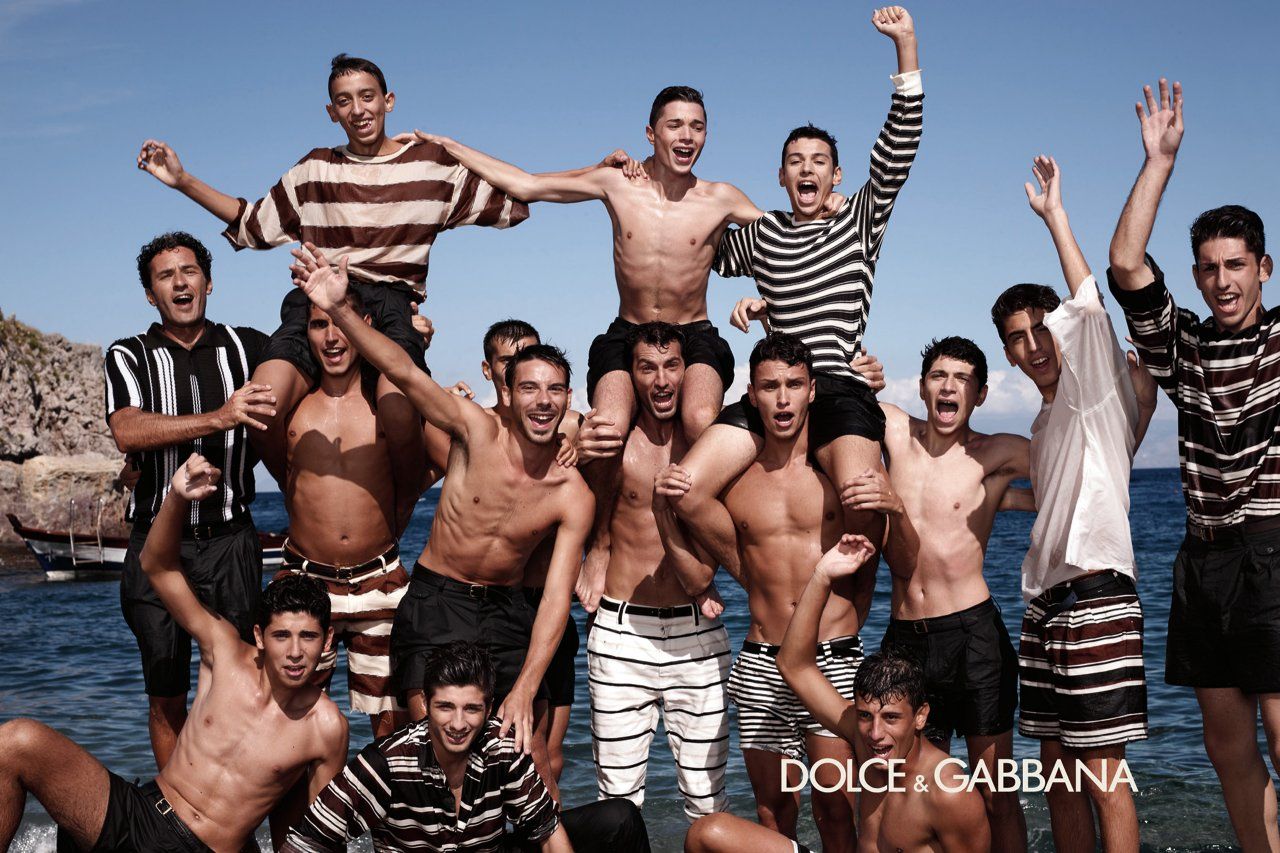
There are arguably no other designers today who are as closely associated with a singular cultural tradition as Stefano Gabbana and Domenico Dolce. Ever since they debuted their brand almost 30 years ago, they have allowed it to speak lovingly and proudly of Southern Italian tradition—specifically, the autonomous culture of Sicily where Dolce was raised.
So it is no surprise that the advertising campaign for their Spring 2013 collection, which was an ode to the region's street festivals, would have been photographed there. But for the first time, Dolce, 54, served as photographer. And Gabbana, 50, was the stylist of record. From the earliest sketches to their Fashion Week runway show and the final sales pitch to consumers, the aesthetic is wholly that of the designers.
"It's like when a movie director creates a movie. You start to look for a [setting] for the actors. We choose the music, the models. The last part is to shoot the -campaign—what we want to tell the audience," Gabbana says.
"To shoot the campaign is like when you make dinner, this is dessert," he says. "It completes the cycle."
Since the modern era of fashion advertising campaigns began, designers have exerted some degree of control over them. Yet despite their domineering tendencies, they typically turned over the final stage of building a brand message to an outside source. More than a few of those designer-photographer partnerships have led to memorable and controversial campaigns. Steven Meisel stirred up a hornet's nest in the mid 1990s when critics dubbed his Calvin Klein advertisements "kiddie porn." Bruce Weber was responsible for Calvin Klein's erotic Obsession fragrance ads. And Marc Jacobs has had a long relationship with Juergen Teller, whose ads for
the designer's signature label look like faded -Polaroids taken in a rec room and bedrooms.
But now, more and more designers have stopped ceding that last bit of artistic power. The explanation is a matter of business, aesthetics, and emotion.
"We didn't have to teach to anyone what we want to do," Gabbana says. "I didn't have to explain what I feel."

The Milan-based designers followed the example of a host of well-known colleagues. Karl Lagerfeld has long clicked the shutter for Chanel. Tom Ford photographs both the men's and women's campaigns for his signature collection. Reed Krakoff, who returned to school to take photography classes, shot ads for Coach, including the memorable images featuring Finney, the Jack Russell terrier. (For the last few seasons, he hasn't had the time to be such a full--service designer.) And Hedi Slimane, who built a respected photography career after leaving the fashion industry, recently returned to helm Yves Saint Laurent and shot the campaign for his debut collection.
The shift is testament to the new role of designers as both businessmen and creative directors who are charged with overseeing everything from the shape of a brand's perfume bottle to the architecture of its global network of boutiques.
Dolce and Gabbana, for example, have wielded business control over their company since its beginning in 1985. As it has grown into an international brand with well over $1 billion in revenue, it has become synonymous with celebrities such as Madonna, Kylie Minogue, and Scarlett Johansson. The duo's empire also includes a Milan restaurant along with a multibrand boutique.
In their roles as both creative and corporate titans, they've also had professional challenges from both worlds. As businessmen, the designers have been accused of tax evasion by Italian prosecutors. Their trial is scheduled to begin Dec. 3; the designers have maintained their innocence.
And some of the artful images in the spring collection—caricatured black faces inspired by puppet shows from their beloved Sicily—have been viewed as racially insensitive. "We are not racists," Gabbana says. "It's part of the culture of Southern Italy."
The decision to photograph the spring campaign followed years of collaboration with celebrated photographers such as Mario Sorrenti, Peter Lindbergh, and Steven Klein. Dolce began to dabble behind the camera and that led to the publication, this year, of Campioni, a photo book featuring young soccer players. When he raised the possibility of shooting the company's advertising campaign, he freely admitted, "I'm afraid."
"He asked what I think," recalled Gabbana. "I said, 'Go! If it's bad, we reshoot it with another photographer.'"
To improve their odds for success, the designers surrounded themselves with technical experts, such as lighting di-rector David Devlin, who has extensive -experience in still photography and
feature films.
Thematically, they were inspired by the 1948 Luchino Visconti film La Terra Trema, about Sicilian fisherman, which the director filmed on location using locals. The designers decided to populate their photographs with nonprofessional models who would pose alongside Italian actress Monica Bellucci and socialite Bianca Brandolini d'Adda.
Gabbana gave them their motivation: "I spoke with all the people and said, 'This is the situation: It's a Sunday on the beach with your family and your girlfriend's family. This is the mood.'"
Adds Dolce: "They're Sicilian. They understand the music. They understand what we want to see."
The result is a campaign that hits the sweet spot of the Dolce & Gabbana canon. Dark-haired men exude earthy machismo and proud narcissism. The women are curvy and sensual.
The background evokes the cultural stew of Sicily and the tenor of life there, especially as it compares to the northern industrial capital of Milan. "It's hot; it's passionate. It's less chic but it's more emotional," Gabbana says of Sicily. "I think the south of every part of the world is very similar."
The campaign is also the start of a new tradition at the brand. Photography, Dolce says, "is my pleasure." And complete control is fashion's new mantra.
Uncommon Knowledge
Newsweek is committed to challenging conventional wisdom and finding connections in the search for common ground.
Newsweek is committed to challenging conventional wisdom and finding connections in the search for common ground.





